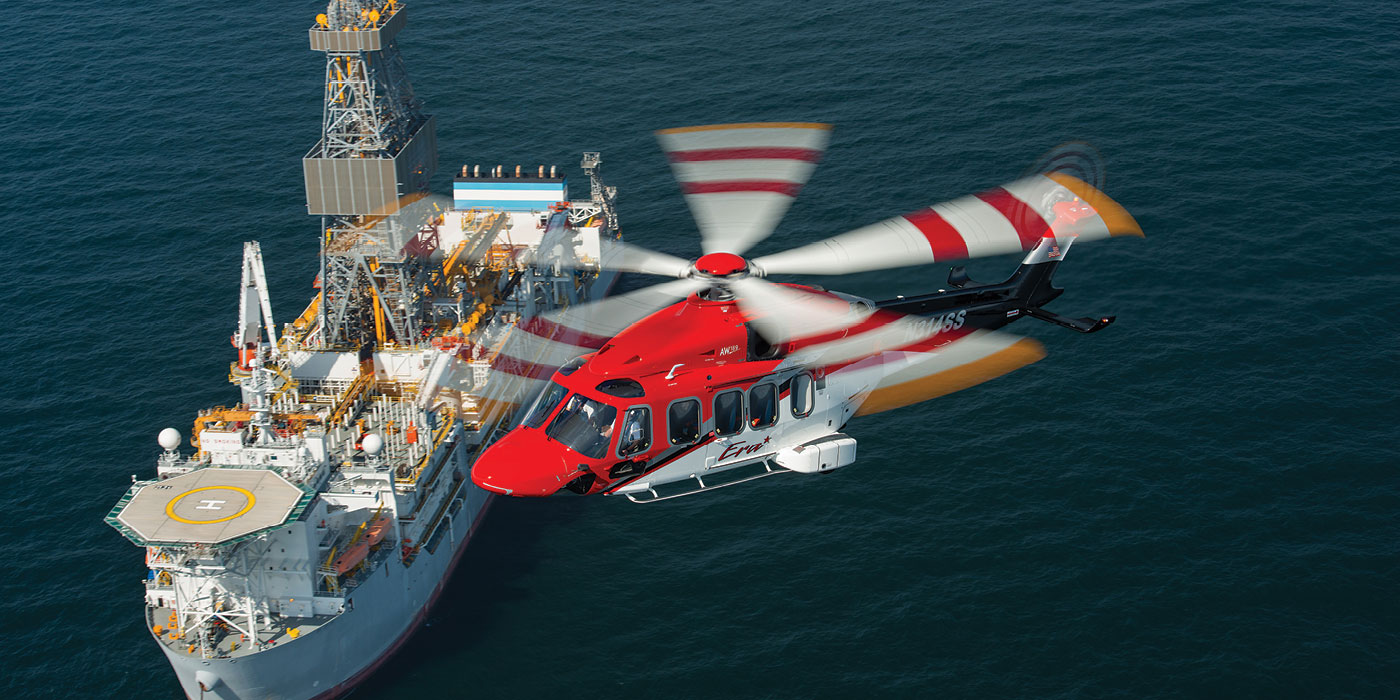
The oil-and-gas industry depends heavily on helicopter operators to provide the diverse logistical support required to help sustain its work. From overland pipeline surveys, to freight transport, and the all-important crew change flights that shuttle workers between the mainland and offshore platforms (some more than 200 miles from the coast), the Gulf Coast helicopter fleet completes hundreds of individual flights each day. While most operators fly from dawn to dusk, there are a few that fly around the clock, providing the oil-and-gas industry with life-saving helicopter search-and-rescue (SAR) and medevac capabilities.
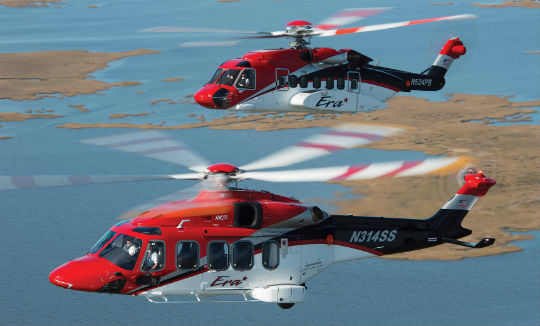
The mid-sized aircraft in Era’s GoM fleet are the Finmeccanica AW139; the Sikorsky S-76C++; and the Bell 212. These medium twin-engine machines are engineered for speed and performance, and they excel in short- to medium-distance offshore missions for up to 12 passengers. The AW139 is also the aircraft of choice for Era’s successful offshore SAR program. Utilizing two aircraft and a third as a backup, the program supports the offshore oil-and-gas industry and is closing in on its 1,000th mission.
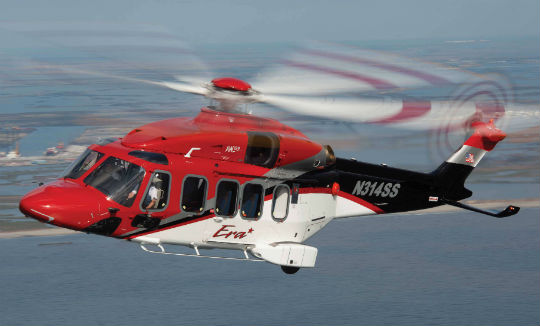
Era’s heavy lifting has long been the sole responsibility of the Airbus Helicopters H225 Super Puma. This mighty twin-engine aircraft has proven itself as a reliable long-range hauler capable of moving up to 19 passengers or cargo to the most distant deepwater platforms. But while the H225 is highly regarded as a reliable and capable performer, Era is always considering ways to improve the fleet and provide diversification and more efficient and cost-effective solutions for its customers. The company’s recent introduction of two new models at the heavier end of the spectrum — the Sikorsky S-92 and Finmeccanica AW189 — is intended to do just that.
The S-92s entered service with Era in October 2015. Similar to the H225, the S-92 can accommodate up to 19 passengers, and with the S-92’s gross weight expansion (GWE) applied, the aircraft’s maximum takeoff weight is boosted from 26,500 to 27,700 pounds (from 12,020 to 12,565 kilograms). The H225 and S-92 will share responsibilities for the furthest missions to deepwater platforms that could extend beyond 200 miles. A total of four S-92s have been ordered to complement Era’s fleet with an option to purchase two additional aircraft.
Launching the AW189
Era accepted its first two AW189s in December 2015. The first began revenue operations in February of this year, making Era the AW189 U.S. launch customer. These big brothers to the popular AW139 are configured for 16 passengers and with increased gross weight (IGW) applied, have a maximum takeoff weight of 18,959 pounds (8,600 kilograms). Era expects the AW189 to be highly utilized within 160 miles of the coast.

“The AMMCs are the central management computers for the entire aircraft,” said Carter. “This gives us the additional safety margin so we know everything is operating as it should be.”

While ease of operation was clearly a major focus in the aircraft’s design, crew and passenger comfort was not overlooked. Crew seats incorporate an adjustable lumbar support system, which certainly makes a difference for pilots during those long days in the cockpit. Carter said that passengers appreciate the space in the AW189’s cabin; while featuring the same number of seats across the width of its cabin (four) as the AW139, it’s 12 inches wider, so each passenger enjoys a bit more shoulder room.
So how is it to fly the AW189? “The AW139 outperforms any other aircraft on the market, and the AW189 is no different,” said Carter. “It has an excellent power to weight ratio, and with the new GE [CT7-2E1] engines, the fuel consumption has come down to levels comparable to the AW139, but still provides the power to carry the extra 3,000-plus pounds more than the AW139. The lower fuel consumption also allows us to carry larger loads further offshore and the OEI [one engine inoperative] performance of the AW189 adds that added safety margin that Era and our customers are looking for.”

Of Era’s 12 bases serving the GoM, the Houma, Louisiana, “super base” stands as Era’s crown jewel. In June 2015, after a two-year, $22 million renovation and the construction of a massive new hangar, Era celebrated the opening of the 35-acre base with a gala ribbon cutting.
The main passenger or “large ship” terminal was converted from the base’s original aircraft hangar. Today, it’s a 17,899-square-foot modern passenger processing facility and VIP-style lounge serving those heading offshore for work. Walking through the front doors one is greeted by an Era employee who assists passengers with the check-in, utilizing automated touchscreen kiosks for ticketing and baggage. A security screening follows, using the same high-tech automated body and baggage scanning equipment used by the TSA in commercial air terminals. “At five in the morning, we rival any TSA security checkpoint. It just flows.” said Kurt Covington, Era’s director of ground operations, who oversaw the project from concept to completion.
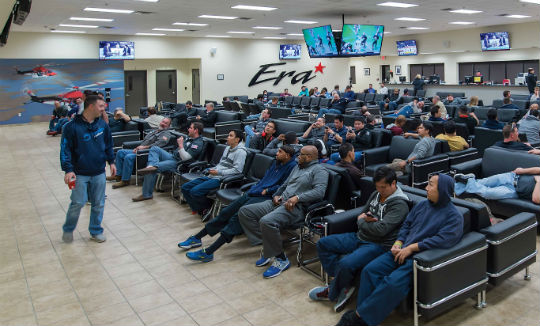
Passengers are then welcomed into the bright, spacious lounge area, where 400 comfortable padded chairs and couches are neatly arranged. They can catch a quick nap or enjoy sports or entertainment programming on 10 large flat-screen televisions that encircle the room. Suspended from the ceiling in the center of the room are four enormous television monitors mounted to create a square, similar to the jumbotrons found at indoor sports arenas. This arrangement allows easy viewing from throughout the terminal for broadcast television, or for streaming Internet content like Era’s real-time flight status and flight tracking.
The terminal provides complimentary fresh brewed coffee and passengers can purchase an assortment of beverages and snacks from vending machines. Free Wi-Fi and a custom charging station for electronic devices provide an extra level of convenience.
Beyond the lounge area are separate passenger briefing rooms. Here, passengers receive their pre-flight safety and procedural briefings before being escorted to their aircraft.
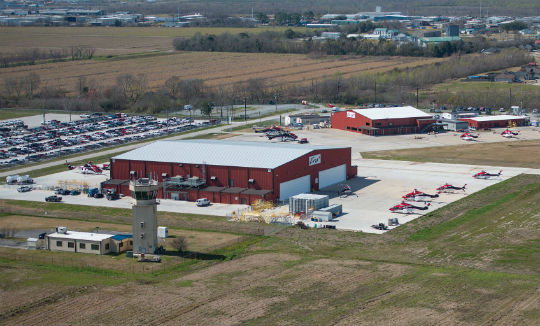
Before the remodel and expansion, the volume of passengers’ cars requiring long-term parking created a parking nightmare. Today, the Houma base has acres of fenced parking immediately adjacent to the terminal. An Era-branded shuttle bus is available for busy periods or runs to nearby hotels.
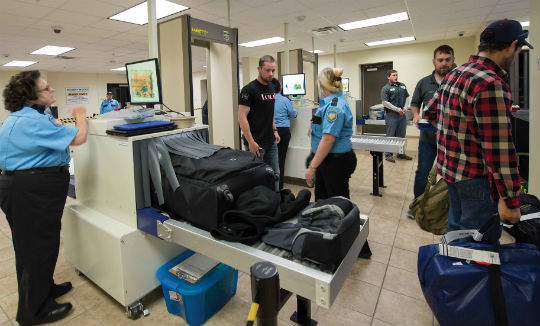
The new hangar was designed with efficiency and safety in mind. Early in the development stages, Era planners met with maintenance representatives from several original equipment manufacturers (OEMs) to understand the many parameters and capabilities the hangar needed to have in order to perform maintenance on such a diverse fleet.
“The biggest key to that was the (crane’s) hook height,” said Covington. “So with the fixtures and the gear to pull gearboxes, we came up with the span of the hoist, the rating of the hoist, and the amount of height we needed on those hoists. Once we determined that, we basically built a building around those cranes. And If I have to do another one tomorrow, we’d take an identical approach.”
The hangar spans 40,000 square-feet with twin hangar bays. Each bay has its own 10-ton overhead crane, and the white epoxy floor provides a bright “foreign object damage (FOD) aware” work environment. Technicians enjoy the convenience of Snap-on Level 5 computerized tool boxes, complete with custom Era graphics, which provide the ultimate in tool control. An additional 8,000-square-feet is dedicated to shops, parts storage and office space.

The hangar is completely climate controlled. So on those summer days when it’s 100 F (38 C) and 100 percent humidity outside, the hangar maintains a comfortable temperature and humidity. Besides the obvious advantage in personal comfort, the environment protects the aircraft from the damaging effect of the humidity outside.
Optimism despite downturn
In the mid-2000s, the price of oil was beginning its most recent surge, and the oil-and-gas industry was buzzing along in high gear. As a result, Era and the other GoM helicopter operators were enjoying a brisk tempo to their business. By the second half of 2014 however, oil prices began to fall and the oil-and-gas industry responded, taking measures to scale back or postpone exploration and drilling. “People are stacking their rigs and are waiting for things to rebound,” said White. “Our operations are down but we serve a pretty diverse group in the GOM. With the reduction in POB [persons on board] count, customers re-evaluate their transportation needs and the ability to reduce costs by optimizing planning and scheduling to optimize POB and enhance efficiencies.”
White said that while Era’s top line revenue may be down year-on-year, it has ample liquidity and a strong balance sheet. “We always run as a pretty lean and efficient company in the first place,” he said. “Obviously if the activity goes down you need to adjust for that, and we expect to come out of this market downturn very strong.”

But folks throughout the Gulf Coast remain confident oil prices will rebound and the oil-and-gas industry will then resume operations in earnest. When it does, Era will be there, with new aircraft and infrastructure — and a legacy of over 65 years serving the oil-and-gas industry throughout the GoM.






